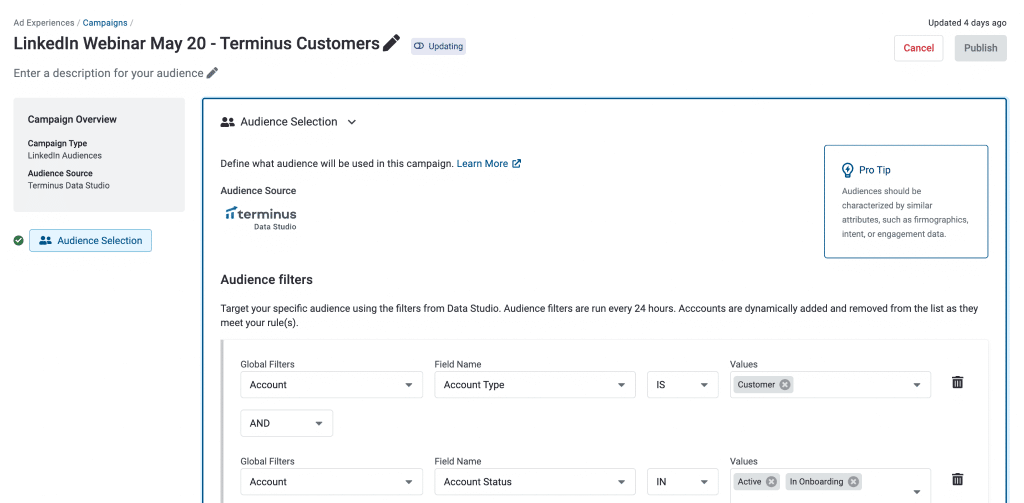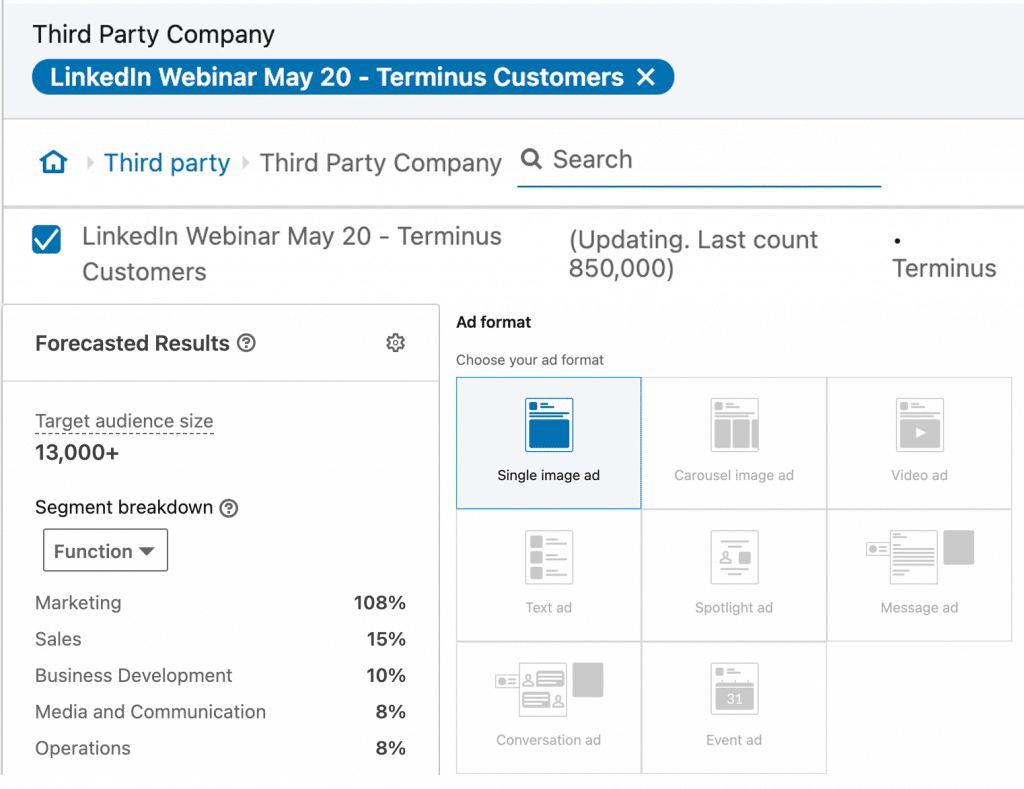Most of us that have been involved in marketing and sales are well aware of LinkedIn. It is where we connect with like-minded professionals and source jobs but it’s also a powerful content delivery tool. Bringing personalized and targeted content to LinkedIn means you’re more likely to connect with your ideal prospect with a message that resonates with them.
Earlier this year we announced our latest integration with LinkedIn Marketing Solutions, a major step we took to deliver seamless activation, larger account lists with improved match rates, flexibility across ad types, and elevated customer experiences. However, understanding how to use LinkedIn as a part of your larger marketing strategy is not always intuitive. Read on to learn the top five best practices that can help you effectively use LinkedIn with your ABM platform and what the results will look like if you do.
1. Leverage LinkedIn-Specific Functionality
Even if you’re an experienced digital marketer, targeting on LinkedIn can be different from other platforms and it helps to know what unique functionality LinkedIn can offer your program. Location is a mandatory targeting field in LinkedIn and also a field where you can get specific, such as calling out country, state, or cities. It’s important to factor LinkedIn into how you think about segmenting your audiences across your ABM strategy. When setting up your campaigns, you can start by combining specific targeting criteria, such as company, demographics, and job experience (which is specific to LinkedIn) to build your ideal persona, and then leverage Linkedin to target these personas 1:1.
LinkedIn as a marketing solution has also identified key words that are known to inspire action such as “leader” and “success”. Understanding what is going to resonate with your audience on LinkedIn is critical to influencing that audience to take action.
2. Optimize on Ad Frequency
Frequency capping on LinkedIn is important to understand, and a nuance that is critical to navigate. The frequency at which you serve ads to a target persona can be an advantage to your marketing program, because it means your content is getting in front of your target audience at regular intervals, which ensures that your brand will be the first one that comes to mind later on. With other forms of advertising such as display advertising, frequency capping can be controlled. However, with LinkedIn, frequency is limited to serving one ad per every 48 hours for an individual persona (hint: that’s pretty limited!). However, by creating up to five different ad sets, you can increase frequency and show an ad to a singular persona five different times. Adding additional ad sets works especially well for niche audiences with more targeted spend.
You can also increase frequency by spreading out content types across LinkedIn – such as across sponsored content or carousel content. In doing so, users can be put in multiple campaigns with different types of creatives so that you can hit them with targeting at a higher frequency.
3. Keep Your Content Relevant and Consistent
While frequency across LinkedIn campaigns is important, all of this needs to be tied into your ABM strategy with messaging. Think about the types of content you are sharing based on the stage of the account – are they at an awareness stage or top of the funnel? Or are they in the middle or bottom?
For top of funnel, messaging should remain consistent across your ABM platform and be focused on sharing content and messaging such as insights, industry trends, or by sharing top of funnel content like eBooks. For mid-funnel, you can get a bit more tactical, such as sharing tools or templates that your target personas could use day-to-day. Bottom of the funnel is where you can start to get granular and show customer case studies or use cases. Remember to make sure that the content and messaging you are sharing is relevant to your audience based on where they are in the buyer’s journey.
When you orchestrate your messages consistently across channels, you can create cross-channel alignment, this is especially impactful when you bring your native channels into the fold so you can get a true picture of how your brand is resonating. This can look like building lists in the Terminus data studio, segmenting these lists based on the buyer’s journey, and running persona-specific LinkedIn ads based on how you’ve curated your audiences.
4. Generate Clear and Purposeful CTAs Based on Buyer’s Journey
So you’ve deployed relevant content based on where your personas are in the funnel, but this all goes to waste without leveraging a clear and purposeful CTA. First, think about what action you really want your target audience to take. For example, a CTA for top of funnel might look more informative, such as “Learn more”. Mid-funnel CTAs might ask for webinar signups or demo participation, and bottom of funnel might send your audience to your sales team.
Remember, they aren’t going to download your ebook unless they have awareness of your brand. It’s important to evaluate where accounts are at when you consider them top of funnel, and ask yourself if they are even aware of your brand and make decisions based on that. Without doing this, it’s kind of like asking me for my phone number and I don’t know your name.
5. Have Your Testing Strategy on Hand
Test, test, test! Don’t forget to come to the table with your A/B testing strategy in hand. There is no better way to understand what is or isn’t working than testing the different elements of your advertising and targeting practices. Testing will allow you to monitor ads that are being shown to specific audiences and understand where to make pivots or adjustments.
Look at click-through-rates as a way to evaluate messaging and creative performance, and not the overall efficacy of the channel. For efficacy, looking more holistically at revenue and pipeline is a great way to measure the overall success of your ABM platform.
Putting This Into Action
As an example, we can show how we set this up for our own campaigns in Terminus Ad Experiences. To start, we built targeted lists within Ad Experiences that automatically connected to our LinkedIn Campaign Builder account. This process was done by creating specific audience filters based on attributes like Account Type, Account Status, and more. Our lists contained accounts pulled straight from the Terminus Data Studio!

Once our lists were built within Terminus Ad Experiences, we then synced our audience with our LinkedIn Campaign Builder. This was done by selecting “Third Party Company” under the Audience Selection tab.
After the sync, we were able to see a breakdown of the quantity and role types of our targeted audience members. We utilized a single image display ad within this campaign, but our LinkedIn integration is compatible with any ad type of your choosing!

So what do we want you to take away?
When it comes to choosing granularity of targeting over broad reach across your ABM platform – choose LinkedIn. Running LinkedIn campaigns that hone in on specific personas within your accounts will allow you to access the wide breadth of job titles that LinkedIn is home to today. LinkedIn is also a great option for one-on-one targeting globally and should be considered as part of your larger global strategy.
By using LinkedIn with Terminus, you take advantage of larger target lists, support for all ad formats, better account match rates, and the ability to create one audience to use across multiple plays within LinkedIn. On average, display ads see .03 -.05 click-through rate. On LinkedIn, content is experiencing roughly .25% – .5% click-through rate across all content funnels.
With improved account matching and targeting, you’ll be able to recognize a significant increase in the Terminus accounts that match to companies on LinkedIn. LinkedIn is a powerful channel for ABM, and connecting it to your ABM platform (like ours!) means you can run consistent campaigns across ads, email, chat, and your entire platform to target accounts and specific contacts with consistent and personalized messaging. In doing so, you benefit from better engagement across all of your marketing efforts, wider reach across your accounts and with your targeted buyers, and the consistency of relevant and targeted content that hits your accounts in surround-sound at the moment they are most ready to receive it.
Are you ready to launch? Go here to learn more.